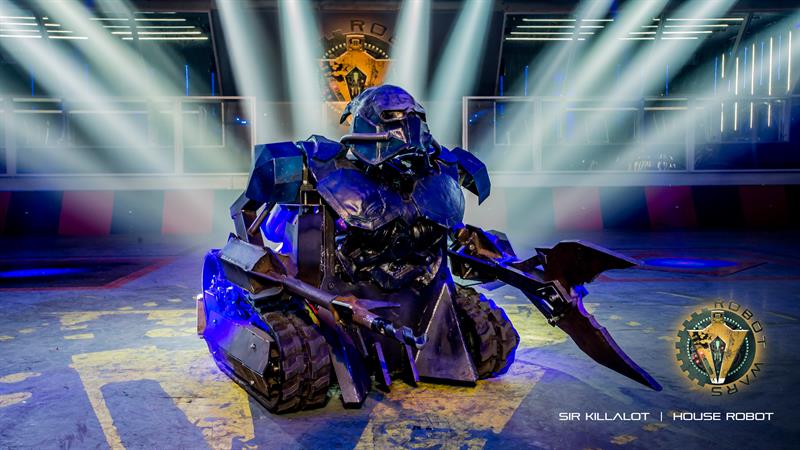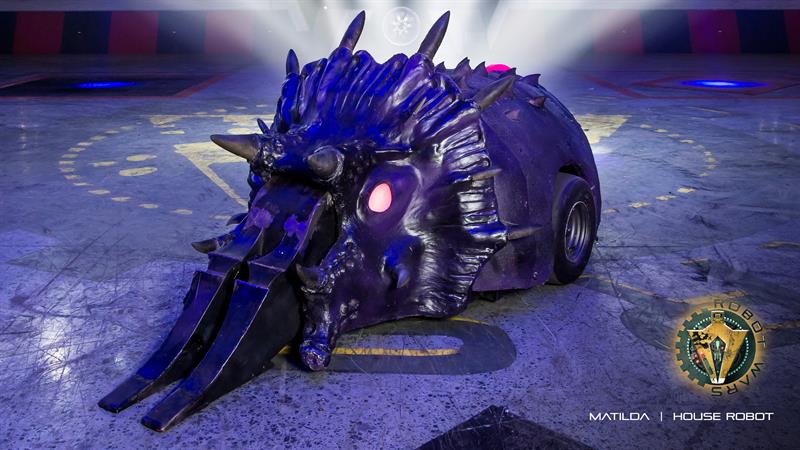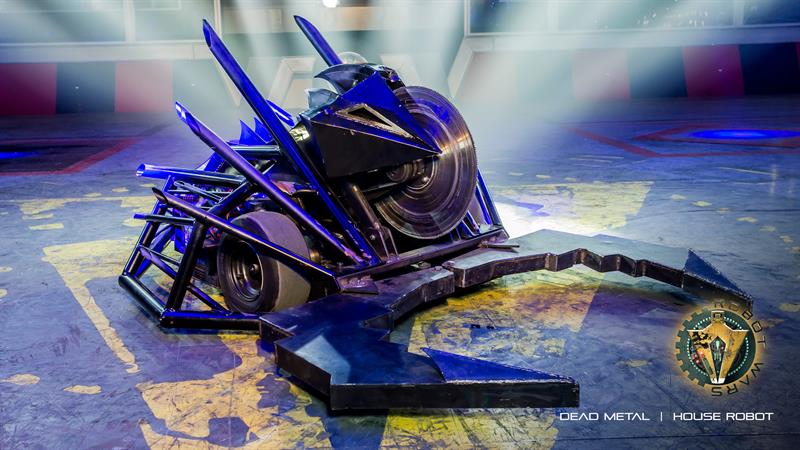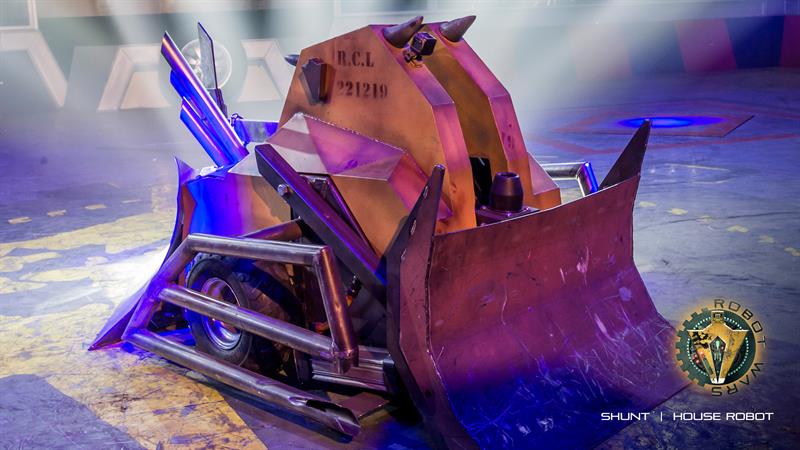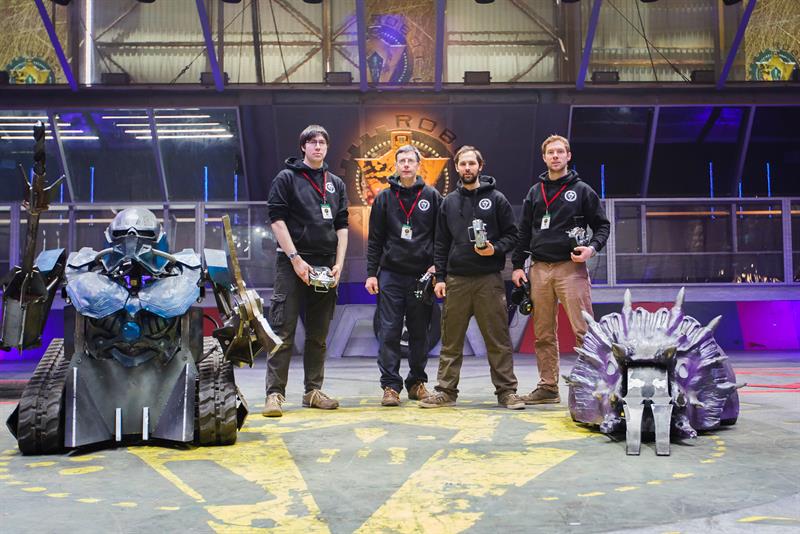Three. Two. One. Activate. As those immortal words rung out once again on our screens over the summer, it marked the fact that Robot Wars is at last back on our screens, with a host of competitors, new and old, willing to do battle. As the whir of motors echoed around the arena, it didn’t disappoint, with plenty of metal-on-metal clanging, banging, scraping and screeching, each escalating the roar of the crowd.
Contraptions came in all shapes, but mostly larger sizes, and were armed with all kinds of weapons. The engineering behind the robots was a marked improvement since the show last aired in 2004. The quirky cult competition draws entrants from grassroots enthusiasts to professional engineers. There were few weaker robots this time around and all suffered considerable damage. Competition for the top spot was tighter than ever.
Besides the intrigue of just what the competitors will come up with to do battle, are the other stars of the show, the antagonistic house robots. Bigger, meaner, heavier and incredibly well engineered, the house robots act as obstacles in the fight arena that must be able to engage any of the competitors and comfortably come out on top.
To make sure that the house robots were up to the new and improved class of 2016, the BBC got in touch with a Birmingham based technology specialist with a history of building all kinds of weird and wonderful contraptions for television.
James Cooper, creative technologist at Robo Challenge, explained the design objectives: “We knew the house robots couldn’t just start where they left off. We looked at the original house robots and knew they weren’t anywhere near to being up to the job. The new competitors would destroy them. So, the brief was, ‘make the original ones look like toys’.”
Technology has moved on considerably since 2004, meaning that while the new house robots might resemble the old ones, not a single bolt was re-used from the originals. Cue military grade armour, a 2.5 tonne-force hydraulic pincher, a liquid CO2 high pressure pneumatic flipper to throw the 110kg competitors over the 5ft plus arena walls, and more.
Moving forward
One of the biggest changes has been brought about by developments in battery technology, driven largely by the increasing electrification of the automotive industry. While competitors of old used to commonly opt for a car battery, modern lithium polymer batteries are lighter and offer significantly more power. That then has knock-on benefits when combined with more efficient motors and improved control systems. It means, overall system efficiency is up, making for faster and more powerful combat on the arena floor.
Other improvements come in the shape of pneumatics, hydraulics and linear actuators – all put to use by Robo Challenge depending on the application.
“Sir Killalot’s jaw is hydraulics,” said Cooper. “It’s a relatively slow but very high power pressure mechanism. He has got about 2.5 tonnes crush in his left arm and can lift 300kg, which is nice and controlled.
“Matilda on the other hand is liquid CO2, so here high pressure pneumatics gives us an extremely high speed weapon. Now we have enough power to throw competitors out of the arena. And then we might use linear actuators to adjust ground clearance. So we assess what works best.”
However, while technology improvement certainly made the potential for improvement look good on paper, the big obstacle for Robot Challenge was the timeframe to complete the redesign and rebuild of four of the house robots: Sir Killalot, Matilda, Shunt and Dead Metal.
“It was an incredibly tight schedule,” said Cooper. “They only gave us 3.5 months from the green light to build them before filming started.”
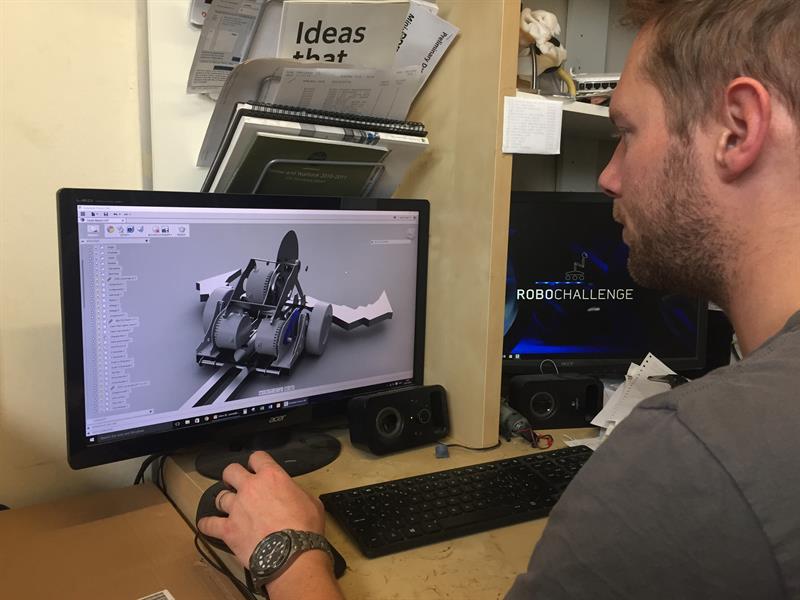 To overcome this fierce time pressure, the team used a number of other technology improvements, namely 3D CAD for the design and 3D printing to produce parts and moulds. The team worked with Autodesk, applying its Fusion 360 software to allow the design of the organic shapes and structures to give the robots facial features and personality, while at the shape time strength, rigidity and often functionality.
To overcome this fierce time pressure, the team used a number of other technology improvements, namely 3D CAD for the design and 3D printing to produce parts and moulds. The team worked with Autodesk, applying its Fusion 360 software to allow the design of the organic shapes and structures to give the robots facial features and personality, while at the shape time strength, rigidity and often functionality.
Paul Sohi, a product designer at Autodesk worked with Robo Challenge on the project. He said: “They gave me a ring and say they’d won the project and wanted to use Fusion 360 to build the house robots. Robot Wars being what it is, I leapt at it!”
Rather than a passive system where you have to input geometry, Fusion 360 allows the designer to stipulate conditions, so for example, what the loads are going to be, the material and then the connections. The software is then able to come up with the optimised outcome. It’s very much along the lines of topology optimisation, and often lead to the organic structures that are increasingly being produced by 3D printers.
“I trained them in some of the more advanced tools in Fusion 360,” said Sohi. “For example, Sir Killalot’s face and head are quite organic, so we use that as a training exercise.
“The benefit of doing it on the computer first is that you also can simulate everything. A robot with so many moving parts, it’s essential to make sure it all works. So when the weapon is operating is there interference anywhere? Also, can the robot handle the power of its own weapon, so will the 600psi hammer that’s coming down make the robot fall apart? You can check that in the system.”
Fusion has finite element analysis built in to it, enabling the team to do a variety of static stress, model stress and thermal stress analysis. In conjunction with a fair bit of 3D printing, it allowed the whole design to evolve quickly, but with a great deal of confidence.
“We were able to make the designs, and 3D print them to show the BBC to make sure they were happy and get our designs signed off very quickly,” said Cooper. “It meant we were able to quickly crack on with building them and do all the necessary stress analysis.
“If you imagine what the old BBC team would had to have done, they’d have to model them in clay first, and then get those signed off by the BBC. That would take such a long time, time we didn’t have.”
An example is the design of Matilda’s horns, which needed to look like they’d been grown rather than CNC turned or milled. So, the team designed the organic parts in CAD and then 3D printed the moulds.
“That is a very quick process,” said Cooper. “I could design all of Matilda’s horns in a couple of hours and have them on the 3D printer to have physical copies to show the BBC the following day. It is nice to set things on the printer and come back in the morning and it’s made for you. It is quite a strange feeling when you first do that as we are very hands on engineers.”
No constraints
Unlike the competitors, Robo Challenge had little constraint. It meant that the likes of Sir Killalot could utilise military grade specialist steel armour in the form of ultra-tough, ultra-hard, Armox, designed for high wear and extreme impacts. However, this didn’t come without a weight penalty, meaning the house robots weigh close to double that of the originals. That’s no bad thing, however. Though almost every other moving vehicle is looking to shed weight, combat robots now have flippers that can comfortably lift 300kg or more. The extra weight also helps keep the house robots grounded.
“They’ve all needed to be scaled and beefed up,” said Cooper. “We need these specific grades of metals to secure the vitals on the house robots and make sure they are well protected.
“If you think of the old Sir Killalot, that weighs as much as the drive system of the new one. The new ones are all so much bigger and stronger than the originals.”
all so much bigger and stronger than the originals.”
The need to ‘beef up’ the robots was essential given the competitors robots are over 100kg and tremendously powerful and dangerous. So if, for example, a robot is damaged and becomes uncontrollable but still ‘active’, it would be far too dangerous to send a human in the arena. It means, Sir Killalot needs to be able to take care of business without worrying about incurring damage itself.
“We can stop even the most powerful competitors,” said Cooper. “Sir Killalot’s left arm alone weighs more than any of the competitors, so he is monstrous compared to them and can lift them 6ft in the air, no problem.
“Taking on the meanest robots, not just what we have seen in Series 1, but going forward, the competitors are going to again step-up that much more again. So we need to think about what is possible for the competitors going forward.”
Robo Challenge is sure it will be able to keep ahead of the competition for at least five years and will continue to be a match for any competitor. But the house robots will also evolve to make them even more powerful, though Cooper remained tight lipped about exactly how.
What happened to the old ones?
The original house robots were made by the now defunct BBC Visual Effects Department. When the series went in to hiatus, the robots were then put in to storage, reportedly temporally lost, re-found, and according to most reports, they currently remain in storage.
The House Robots Sir Killalot
Sir Killalot is Robot Wars royalty, first appearing in Series 2. He is the robot to beat all others, and with a weapon that weighs more than any of the competitors it can only mean trouble for anyone who dares enter the Corner Patrol Zones (CPZs). If competitors enter this area or get pushed in to it, then they face potential being immobilized. Sir Killalots only weakness is his slow speed, but if he does get a hold of competitors, expect them to be quickly damaged beyond repair. Weight: 741kg Arm lift: 300kg Pincher grip: 2.5 tonnes Speed: 10mph Matilda
Perhaps the most famous house robot of all, Matilda has been around from the very beginning. Her organic features give her a dinosaur-like appearance, and over the years she has taken on a feisty persona. In past form, she has been virtually destroyed by competitors, but has since been redesigned with tougher armour, a 55 bar pneumatic flipper, and a rearward spinning circular saw made of Hardox steel. Weight: 350kg Circular saw: 1500rpm Head lift: 1.5 tonnes Speed: 14mph Dead Metal
Also around from series 1, Dead Metal uses an exterior metal framework for protection, with armour much closer to its internal structure. It is particularly dangerous to competitors as it clings on to competitors and then lowers its magnesium circular saw down to inflict damage. Due to its weight advantage, once you are in Dead Metal’s grips, it can be difficult to escape. Weight: 343kg Pinchers: 300kg Saw Speed: 4000rpm Speed: 13mph Shunt
As the name suggests, Shunt uses more of a brute force approach. It’s weight advantage over competitors means it can comfortably push competitors around while inflicting damage from its overhead titanium tipped axe. Its front bucket can also lift 350kg and dump competitors down the pit, or into harm’s way. Weight: 327kg Bucket Lift: 350 kg Axe Speed: 250ms Speed: 11mph |
Fancy your chances? The rules for competitors are much more constrained than those of the house robots, so don’t be expecting to be able to take them on in the arena. However, if you do fancy your chances and have a design in mind, why not enter? “In general, robotics has become so much more affordable than when it first aired,” said Paul Sohi, a product designer with Autodesk. “It means the entry point is much more accessible. Parts are cheaper and the way to build has become much easier. There is a wealth of free knowledge out there.” One thing is for sure, there is no clear weapon of choice in the modern wars. While flippers were favoured early on, a variety of spinning, hammering and clamping weapons have all been used with great effect. A full list of rules is available at www.robotwars.tv but here are some of the biggest constraints.
|
About Robo Challenge The company is a family business that started in 2007 to bring ideas to life for television shows or PR stunts. James Cooper, creative technologist at the company was a fan of the original Robot Wras, so to recreate, and improve the house robots, was a dream project to work on. “We are a very hands-on small team that have got a really nice workshop here in Birmingham,” he said. “Every couple of weeks we are working on something new. It’s never off the shelf stuff, it always tends to be things that haven’t been done before.” The company share a premises with the other family business, a wheels and casting manufacturer. The company building is 80 years old and was built by Coopers great grandfather. “My brother and I were completely inspired by the original series of Robot Wars,” he added. “We started with remote control cars and strapping bits and bobs on the front to do battle with our friends when we were at school. “The BBC needed a partner that knew what they were doing, could produce what they needed, and our background in helping TV shows and heritage and inspiration from the original series, made this a perfect thing to come together and we jumped at the opportunity. It was amazing for us, as it was the dream show to work on.”
|








